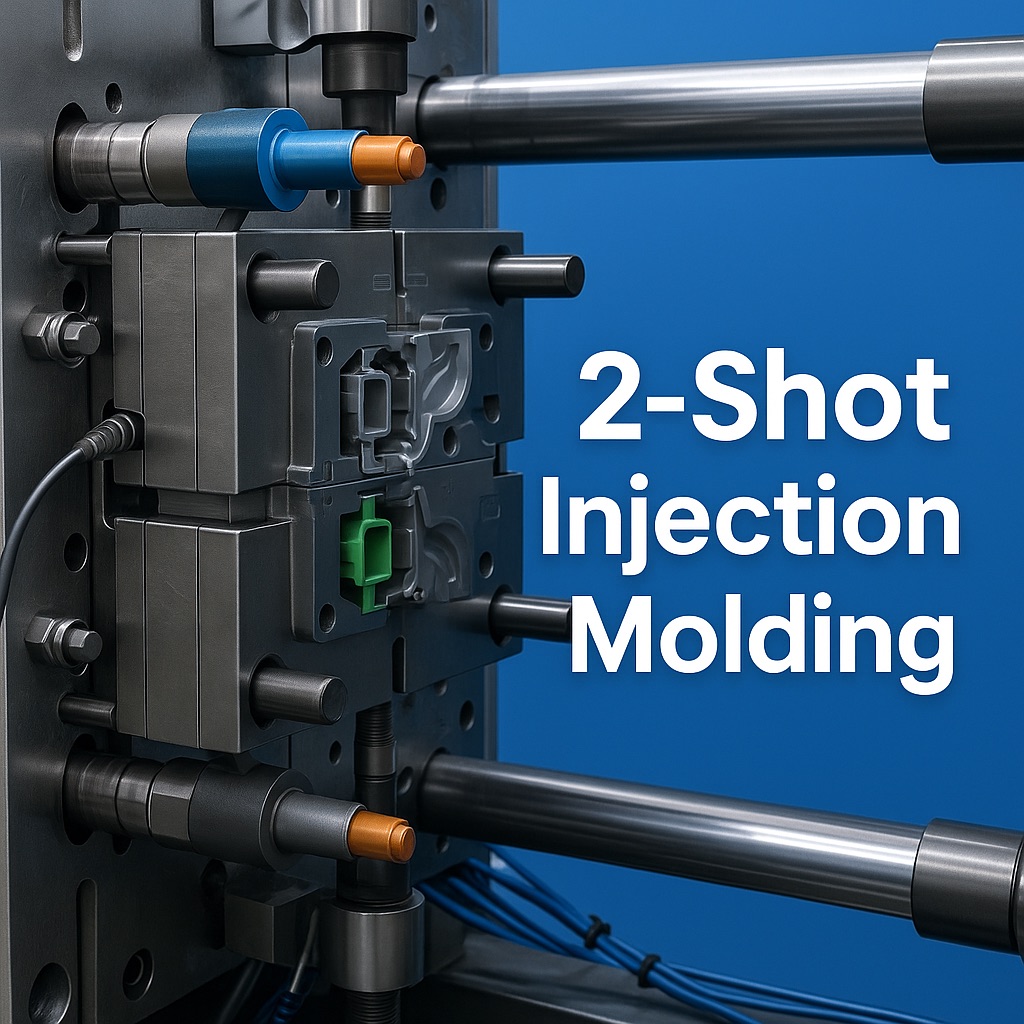Implement 2-Shot Injection Molding for Complex, Multi-Material Parts in a Single Cycle
Implement 2-Shot Injection Molding for Complex, Multi-Material Parts in a Single Cycle
Two-shot—or 2 Shot Injection Molding—combines two different polymers (or colors) in one mold, one press, and one uninterrupted cycle. The result: perfectly bonded, multi-material parts with sharper cosmetics and tighter tolerances than any two-step over-molding process can deliver. This guide walks you through the design, tooling, and process tactics that turn two-shot technology into a competitive edge for wearables, medical devices, appliances, and automotive interiors.
1 Why Two-Shot Beats Traditional Over-Molding
| Benefit | Two-Shot (Single Cycle) | Over-Molding (Two Cycles) |
|---|---|---|
| Bond Strength | Chemical/mechanical interlock at melt temp | Mechanical only; surface prep critical |
| Tolerances | Zero part-handling shift | ±0.1–0.2 mm misalignment risk |
| Cycle Time | 1× combined cycle | 2× cycles + robot transfer |
| Unit Cost @ 100 k pcs | 5–15 % lower | Higher press hours & scrap |
| Automation Footprint | Single rotary or shuttle mold | Two presses + transfer robot |
2 Design Rules for Two-Shot Success
-
Cavity-to-Core Orientation
First shot forms the rigid substrate; second shot adds soft grips, seals, or decorative accents. -
Overlap & Undercut Geometry
Minimum 0.5 mm overlap and/or 1 mm undercut prevents delamination under load. -
Wall-Thickness Harmony
Keep the second-shot wall ≤ 70 % of the first to minimize warp. -
Draft Angles
≥ 1° on both materials—account for differing shrink rates (e.g., PC/ABS vs. TPE). -
Gate Strategy
Position gates to hide weld lines under cosmetic ribs or behind logos.
3 Material-Pairing Cheat Sheet
| First Shot (Rigid) | Second Shot (Soft / Decorative) | Notes |
|---|---|---|
| PC/ABS | Medical-grade TPE | Good for handheld devices; laser-etch icons on PC side |
| PA 66-GF | TPU, 60 ShA | Automotive pedals; verify adhesion promoter |
| PP-Talc | SEBS-TPE | Appliance knobs; low-cost, recyclable |
| PEEK | PEEK-colored (implantable) | Mono-material bond, different additives |
| Clear PC | Color-tinted PC | Two-color light pipes; no adhesion issue |
Tip – Always request the resin supplier’s two-shot compatibility chart, then run a 180° peel test to confirm bond strength > 6 N/cm.
4 Tooling & Machine Considerations
| Element | Best Practice |
|---|---|
| Rotary Platen vs. Shuttle | Rotary (index) for symmetrical parts and high volume; shuttle for asymmetric or large parts. |
| Hot-Runner System | Valve gates with separate temp zones for each material; avoids stringing. |
| Thermal Isolation | Insert ceramic or air gaps to keep first-shot cavity warm while second shot cools. |
| Mold Alignment | Use tapered leader pins and cavity interlocks; misalignment tolerance ≤ 0.01 mm. |
| Cavity-Pressure Sensors | One per shot to fine-tune V/P switchover and pack pressure—essential for balanced bonding. |
5 Process Window—Key Parameters
| Parameter | Target Range | Why It Matters |
|---|---|---|
| First-Shot Melt Temp | 220–260 °C (polymer-specific) | Ensures substrate surface is hot enough for bonding. |
| Transfer Time | ≤ 2 s | Substrate surface must stay above Tg for chemical adhesion. |
| Second-Shot Melt Temp | 10–20 °C above first shot | Promotes interface fusion without flashing. |
| Mold Temp Control | Separate circuits for A/B halves | Balances shrink and reduces warp. |
6 Validation & Quality Checks
-
Peel / Lap-Shear Testing — ASTM D 3167 or customized geometry.
-
Cross-Section Microscopy — Confirm knit-line integrity and no voids.
-
Color Registration Audit — Vision system checks ΔX ≤ 0.05 mm between shots.
-
Cycle-Time CpK — Monitor cavity pressure; lock CpK ≥ 1.67 on shot weight.
7 Use-Case Highlights
| Sector | Two-Shot Part | Value Delivered |
|---|---|---|
| Wearables | Smart-watch bezel + silicone seal | IP68 in one shot; zero adhesive lines |
| Medical | Catheter hub with colored ID ring | ISO 10993 materials, no secondary assembly |
| Appliance | Dishwasher knob with soft-touch grip | Scratch-proof color inset, premium feel |
| Automotive | HVAC dial with light-pipe icons | Day/night readability; fewer SKUs |
8 How TaiwanMoldMaker.com Speeds Two-Shot Projects
-
DFM in 48 Hours — gate, overlap geometry, rotary vs. shuttle recommendation.
-
In-House Two-Shot Presses — 120 t–450 t machines with rotary platens and valve-gate hot halves.
-
Material Stock — PC, PC/ABS, PP, TPE, TPU, and FDA-compliant grades on hand for sub-week trials.
-
Sensor-Based Validation — cavity-pressure data logged from T-1 to production.
-
Prototype-to-Scale Credits — aluminum pilot tools credited toward multi-cavity H13 production molds.
???? Explore Related Services
Ready to Merge Two Materials in One Cycle?
Upload your CAD and performance targets to TaiwanMoldMaker.com for a free 48-hour two-shot DFM review, resin compatibility matrix, and costed timeline—so your complex, multi-material parts hit market faster and stronger.









